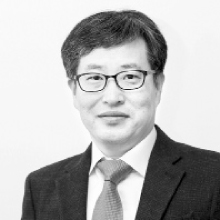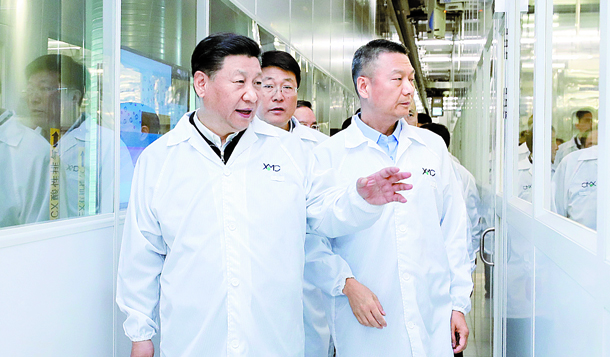A threat from within

The author is an editorial writer of the JoongAng Ilbo.
“The real game starts now,” Samsung Electronics Vice Chairman Lee Jae-yong coolly told President Moon Jae-in after he expressed concerns about the downturn in semiconductors, a key revenue source for the company, as well as for the country. What Lee said reflects the reality of semiconductor cycles. The industry is a big league. Only the strong, who can invest heavily during a slump and build economies of scale to overwhelm others, can survive in the game.
The chip sector’s revolving business cycle is a ruthless creature. The boom-bust cycle is inherently dramatic. In the mid-1980s, prices of dynamic random access memory (DRAM) chips plunged to bargain basement levels amid dumping by U.S. and Japanese chipmakers after Samsung Electronics developed the 64K DRAM. At the time, the fearless newcomer raised the bar and ramped up its capacity for the production of 256K DRAM. Samsung would not have gotten to the top had it hesitated to invest during the down cycle.
During the worst chip slump in 2002, smaller local DRAM maker Hynix struggled to survive on creditors’ largesse and was on the brink of being sold to U.S. competitor Micron Technology. Management and employees were determined to remain afloat and independent. Forbes said Hynix “used up its last lifeline” by rejecting a $3 billion offering from Micron. If Hynix had thrown in the towel at that time, it could not have joined the SK Group and ascended to the No. 3 position in the global semiconductor industry. Over the years, others — Qimonda, the memory unit of Germany’s Infineon Technologies, and Elpida of Japan — went under as they could not endure such a high stakes game of chicken.
Korean players face a stronger contestant, China, which is backed by the cash-rich Beijing government going all-out to achieve supremacy in component technology. Washington’s trade offensive has bought some time for the Korean team, but the Chinese will get back in the ring sooner or later.
The South Korean government has finally stepped in. It pledged to invest 1.6 trillion won ($1.4 billion) to create a semiconductor cluster. SK Hynix responded by offering to invest 120 trillion won in the project over the next 10 years. But the cluster has also become a political competition. Local governments have all decided they want to bring home the mega project. Yongin, Icheon, Cheongju, and Gumi cities, and South Chungcheong, all entered the race. One of the candidates is even fielding a politician from the region who recently joined the Blue House.

Chinese President Xi Jinping visits Wuhan Xinxin Semiconductor Manufacturing Corp. in Wuhan, the capital of central China’s Hubei Province, April 26, 2018. [AP/YONHAP]
SK Hynix is busy fending off the overzealous contenders. It will have to deal with lawmakers from the regions. The government, as well as the company, may have a preferred location in mind based on such considerations as infrastructure and the availability of engineers. But there is not much time left. Even when the location is decided, construction may only begin in 2021 after various licensing procedures. The M16 wafer fab facility by Hynix in Icheon, Gyeonggi, would be completed by 2020. If the government dilly-dallies in fixing the location for the cluster, Korea’s chip-making industry may fall behind its global competitors. No one knows what will happen in the industry during the time.
Industry experts believe China is behind Korea by one year in chip technology. One year is relatively long in the semiconductor industry, where tech cycles move at a dazzling pace. But Korea’s position is unsafe if it wastes time. The bigger threat comes from within, not from China.
JoongAng Ilbo, Jan. 24, Page 30










with the Korea JoongAng Daily
To write comments, please log in to one of the accounts.
Standards Board Policy (0/250자)